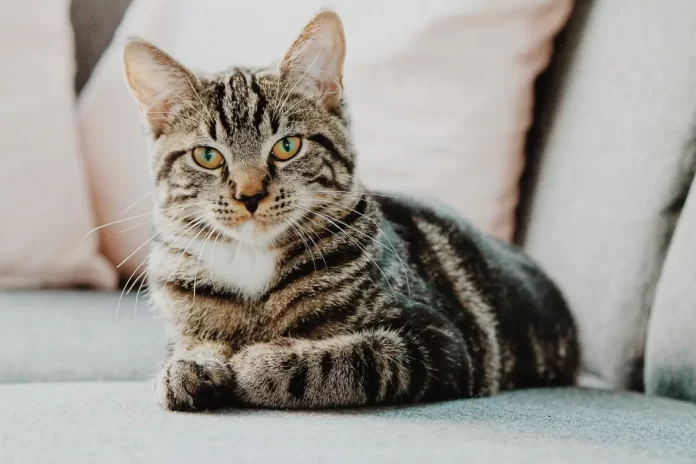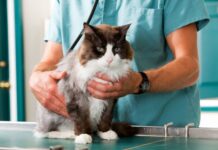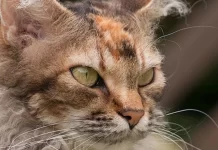Last Updated on August 11, 2023 by Fumipets
Exploring 5 Fascinating Tabby Cat Breeds
Tabby cats are known for their distinctive coat patterns that include stripes, swirls, and spots. Within the realm of tabby cats, there are several intriguing breeds that showcase unique characteristics and personalities. Here’s a detailed look at five captivating tabby cat breeds:
1. American Shorthair: A Classic Beauty
The American Shorthair is a versatile breed known for its longevity, adaptability, and friendly nature. With a history dating back to the early days of American colonization, these cats are skilled hunters and have a sturdy build.
Their tabby coat patterns come in various colors and their easygoing personalities make them wonderful companions for families and individuals alike.
2. Persian: Elegance and Grace
Persian cats are renowned for their luxurious coats, sweet expressions, and tranquil demeanor. While their distinctive flat faces and long coats require regular grooming, their affectionate and gentle nature makes them cherished indoor companions.
Persians come in various colors and their tabby variations exhibit captivating patterns that add to their allure.
3. Maine Coon: Majestic and Mighty
The Maine Coon is often referred to as the “gentle giant” of the cat world due to its large size and friendly disposition. These cats have bushy tails, tufted ears, and a tuft of fur on their paws that resemble snowshoes.
Their tabby coat patterns range from classic to mackerel, adding to their rustic charm. Maine Coons are intelligent, social, and often form strong bonds with their human families.
4. Bengal: Wild Beauty in Your Home
The Bengal cat’s distinctive tabby coat is reminiscent of the wild leopard, giving it a striking appearance. Bred from the Asian leopard cat, Bengals have a playful and active nature.
Their energetic behavior and love for interactive play make them suitable companions for families with an active lifestyle. Bengals come in various tabby patterns, including spotted and marbled.
5. Abyssinian: Ancient Elegance
The Abyssinian cat is one of the oldest known cat breeds, dating back to ancient Egypt. Their ticked tabby coat gives them a unique appearance that sets them apart.
Abyssinians are known for their curious and intelligent nature. They’re agile climbers and thrive on mental stimulation through play and interaction. Their warm and affectionate personality makes them delightful companions.
Domestic tabby cats are renowned for their distinctive coat patterns, much as tigers are recognized for their stripes and cheetahs for their spots. Although “Tabby” is slang for cat lovers, the more people use it, the less clear its true meaning becomes. Although tabby is not a cat breed, several cat breeds include tabby markings.
According to Angelica Dimock, DVM, managing shelter veterinarian at the Animal Humane Society in Minnesota, the genes of a tabby may be traced back to ancient African wild cats that exhibited similar patterns to those of your tabby today. Because of this, even cat breeds that don’t exhibit tabby patterning now contain tabby genes.
Leslie Lyons, PhD, professor of comparative medicine at the University of Missouri College of Veterinary Medicine, says that even your apparently solid black cat may have a distinctive tabby coat; it simply blends in since it is all the same color.
However, certain cat breeds are more renowned than others for having tabby markings. Everything you need to know about tabby cat breeds is outlined here.
What Is a Tabby Cat?
“A tabby cat generally refers to a randomly bred cat that has a pattern of stripes, swirls, spots, or blotches of coloration in the fur coat,” explains Lyons.
Gray, brown, and orange coats are the most typical colors on which the pattern may be seen. What traits do all tabby cat breeds have in common? It’s the letter “M”! All tabby cats have an “M” shape on their forehead, according to Dimock.
However, since our feline buddies often exhibit the tabby feature, the pattern’s appearance will vary widely.
Types of Tabby Cats

The Classic (Blotched) Tabby
The swirl pattern that may spring to mind when picturing a tabby cat is worn by a classic tabby cat, often known as a blotched tabby.
The Mackerel Tabby
The tigers of the tabby cat family, mackerel tabbies have an eye-catching coat of stripes that stands out from other tabby varieties.
The Spotted Tabby
The aptly called spotted tabby shines because of its spots. While spots and stripes are similar, spots seem more like spots because they are fractured and halt in their tracks rather than coming through completely as they do in the mackerel tabby.
The Ticked Tabby
According to Dimock, ticked tabbies may have bands or stripes on their legs and tail but not on their bodies. This is because each strand of their hair has different hues, which “dilutes” the distinctive tabby patterns.
According to Lyons, the ticked tabby is the most uncommon of the bunch, with an Abyssinian (sometimes known as a “tabby Aby”) serving as a fine illustration of the ticked characteristic in action.
The Patched Tabby
Patched tabbies, often known as “torbies,” are cats that have both tortoiseshell (sometimes known as “tortie”) and tabby markings. According to Lyons, “torbies” may have four to five various colorations on their coats since torties are not naturally solid-colored cats.
5 Common Tabby Cat Breeds and What Makes Them Special
Despite sharing a common kind of tabby cat and having a similar appearance, tabby cat breeds have extremely distinct dispositions.
Because the tabby feature is merely a pattern, your tabby cat’s personality is more influenced by its ancestry. More than simply their swirls, spots, and stripes, oh my, these five typical tabby cat breeds are adored.
American Shorthair

The American shorthair is a traditional tabby cat with a proud history of defending buildings from pests. It arrived in America on the Mayflower and immediately instilled dread in all mice.
Although the species has developed into a beloved household pet, its natural hunting instincts should still be encouraged with interactive toys and food puzzles on a regular basis to keep them happy.
Persian

Persian cats may draw attention if they have a mackerel tabby coat, despite the fact that they are most known for their flowing hair and flat features.
However, they are unlikely to be mistaken for tigers any time soon. Persians are only fierce in their devotion to their family, and they like nothing more than to be spoiled and adored by them.
And because they have so much hair, parents of Persian cats should brush their cats every day and start giving them baths while they are young so that it will become a regular part of their grooming regimen as they mature.
Maine Coon

The biggest domestic cat breed, the Maine Coon, is the perfect choice for cat lovers seeking more to adore. Their intimidating bulk is little more than an illusion as they stand tall behind their distinguishing pointed ears and pristine floof coat.
Although fortunately for your lap, Maine coons aren’t normally lap cats, they are gentle giants at heart that like spending time with their family.
Maine coons often have mackerel tabby coats, which, whether or not they are, need to be bathed on a regular basis to maintain silky and smooth.
Bengal

Do not be alarmed; while the spotted Bengal seems to have come directly from the jungle, just a portion of her pedigree is descended from wild cats. The remainder originated from common household cats, and these are the generations of Bengals we see today.
Bengals are not advised for novice cat parents since they must be F4, or four generations, away from their wild cat ancestry, in order to be considered domestic cats. These cats could be outgoing, so they’d probably like going on trips with you – on a leash, of course.
Abyssinian

The “tabby Aby” Abyssinian is lithe, elegant, and graceful, gliding through life eagerly at your heels. It is the embodiment of the ticking tabby.
Don’t be shocked if Abyssinians claim perches or scale cat trees to look down on you from above. Social and inquisitive, Abyssinians are known to follow their owners to keep up with what’s occurring around the home.
The Abyssinian is comparatively low maintenance and just along for the ride, but they certainly do look nice doing it.
Conclusion
Each of these tabby cat breeds brings its own set of qualities and characteristics to the feline world. Whether you’re drawn to the classic charm of the American Shorthair, the regal elegance of the Persian, the wild allure of the Bengal, the majestic presence of the Maine Coon, or the ancient intrigue of the Abyssinian, you’re sure to find a tabby cat breed that captures your heart and enriches your life with their unique charm.
Frequently Asked Questions
What are the key characteristics of a tabby cat’s coat pattern?
Tabby cats typically have distinctive coat patterns that include stripes, swirls, or spots. These patterns often appear on their fur, creating unique and eye-catching designs.
Are all tabby cats the same in terms of temperament?
No, the temperament of a tabby cat can vary widely depending on the specific breed. For example, American Shorthairs are known for their adaptability, while Bengals are more active and playful.
Can tabby coat patterns be found in different colors?
Yes, tabby coat patterns can be found in a variety of colors, ranging from traditional browns and blacks to more unusual shades like silver and blue.
Do tabby cats require special care due to their coat patterns?
In general, tabby cats don’t require special care solely because of their coat patterns. However, certain breeds, like long-haired Persians, may need regular grooming to maintain their luxurious coats.
Are tabby cats more prone to certain health issues than other coat patterns?
Tabby cats are not inherently more prone to specific health issues based solely on their coat patterns. Health risks can vary based on breed and genetics rather than coat color or pattern.


















